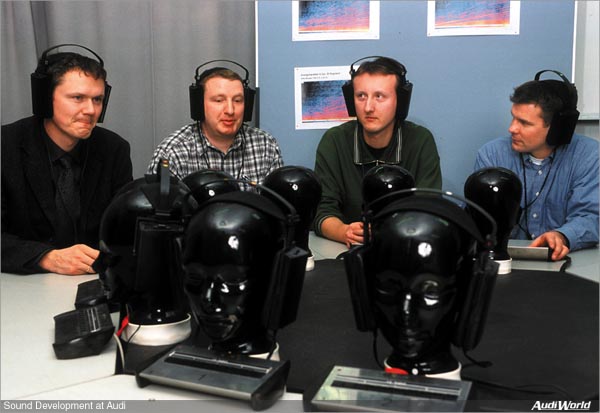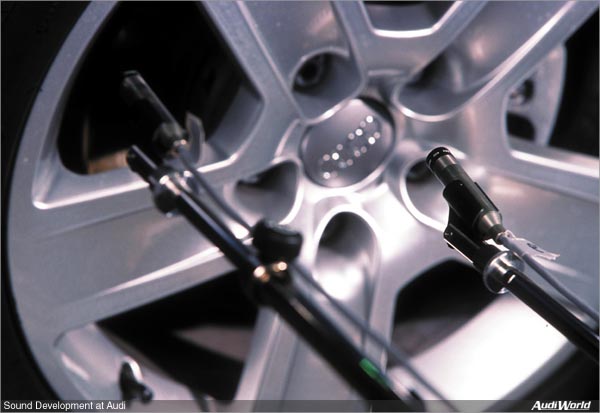The Symphony of the Four Rings

Being music to one’s ears – even the cars from Audi have to be this to a certain degree. Sound design has become an additional important component in vehicle development at the car manufacturer based in Ingolstadt. It is the acoustic calling card of the brand with the four rings, so to speak. The sound an Audi should make depends on each vehicle model – and on the customer’s expectations. The Audi S4, Audi A8 and Audi TT 3.2 quattro are current examples of the active sound design of Audi sounds. Someone who has made a major contribution towards this is Thomas Kriegel, Head of Acoustics for the Audi A4 model series. The engineer uses sound sequences unusual for his profession when speaking and talks about “orchestrated car”, “the art of composing and conducting”, “good musicians” or “wrong notes” and the “symphony of the four rings”. His principles are: “the sound must meet the listener’s expectations. Sound evokes emotions.” He demonstrates this with a concrete example: together with a photo of a pils glass, he plays the sound of tap water being poured into a glass. Instinctively, the listener frowns: the two don’t match! “That’s right, the expectations have simply not been fulfilled in this case.” And this is just the same with cars. The sound of a car must meet the expectations which its design and model positioning have aroused in the customer,” Kriegel explains. This means that vehicles such as the Audi S4 or the Audi TT 3.2 quattro must also have a sporty-raspy sound – they must ‘sound fast”. In these cases, acoustical restraint would only disappoint the customers. The A8, in contrast, has a sound that reflects comfort with a sporty undertone. Apropos expectations: this is an additional challenge for sound developers. After all, everyone perceives sounds differently. Sound design must ‘objectify’ subjective impressions. The goal being that the Audi sound only meets with positive response. And that taking legal acoustic requirements into account, as well. Incidentally, subjective noise perception is evaluated according to psychoacoustic criteria, whose parameters have been in existence since the 1950s. The evaluation of noises reaches from ‘stimulating’ or ‘soothing’ to ‘objectionable’. Kriegel: “You can say as a rule that the higher the tone, the more unpleasantly it will be perceived by the vehicle’s occupants. Such tones can get on your nerves, and even evoke aggression. And this should not happen when driving. Bass tones, on the other hand, are more likely to be perceived as pleasant.” Mixing the perfect sound balance from all of this is the Audi acoustic engineers’ skill. Kriegel explains that specific sounds must be taken into consideration due to the design aspect during the early development phase of an Audi model: “This is one of the most challenging subjects due to the complexity of it all. And we, in Acoustic Development, are involved right from the very first design sketch – i.e. in the concept evolution phase, years in advance.” And he adds, “Sound design must also always be compromised because of other component and vehicle characteristics, the available space and legal requirements.” For these reasons, it is not possible to carry out every single measure conducive to an optimum sound design. About 45 engineers work on the analysis and design of vehicle sound and vibrational comfort characteristics. Along side that, there is a special team dedicated solely to sound design. In addition, there are numerous experts in individual departments whose work revolves around functional noises. The subject of sound also plays an audible role for the developers of audio systems. And the ‘creaking and cracking’ team at Audi track down annoying squeaking and creaking noises and their causes.
Sound design has been intensively pursued at Audi for roughly two vehicle generations. How should the engine, air intake or exhaust system sound? What acoustic response should be heard when pressing the accelerator, how strongly should road noise be perceived in the interior? Which sounds should electric windows or indicators make? Or how resoundingly should a door lock? – Audi acoustic engineers determine all these noises. In this context, Kriegel likes to speak of the “car as an orchestra”. He differentiates between “good musicians” and “wrong notes” within this orchestra. Naturally, the latter should be played properly. “In the past, the work of an acoustic engineer was primarily targeted at the suppression of sound. We call this sound cleaning,” Kriegel explains. The work has been changed by the demand for “good musicians” in a car. This includes the body, the exhaust system, the engine, air intake and aggregate mountings. Unloved “wrong notes” are created, for example, by the tyres, driveline, transmission, ancillaries and wind noises. The repertoire is varied: tyres can sing, transmissions rattle, body panels rumble and buzz, drive shafts roar, generators wail or drone and fans hiss. Ultimately, almost all noises, be it from the engine, tyres or suspension are passed on to the body. This is only in part due to the sound that is carried through the air. The lion’s share of vehicle interior noise is caused by so-called structure-borne noise; that means the transmission of noise within solids or liquids such as in the steering servo’s hydraulic lines. Without any form of constructive intervention, the body would become an incontrollable source of noise – an orchestra, in which the musicians ignore the score and play what they want. Kriegel and the other acoustic experts at Audi thus take on the role of the orchestra’s conductor. Kriegel: “The vehicle body is just one enormous body of sound and can be compared with the body of a grand piano. A vehicle body that is vibrated by the oscillations of a piece of music by using electrodynamic shakers creates the atmosphere of a concert hall. This equals an over-dimensional loud speaker.” To compose the symphony of the four rings, Audi acoustic engineers ‘play’ numerous design possibilities on a keyboard. The most important principle involves influencing sounds at their source. That is why the efforts of acoustic experts in the engine area are ever increasing. From the choice of material to the engine block’s design, from the specification of the crankshaft’s rigidity to the simulation of the complete driveline, from the calculation of the air-intake charge cycle to the design of the exhaust system’s outlet – the acoustic engineers determine the timbre, from ‘piano’ to ‘fortissimo’. Various features are fitted to reduce the transmission and emission of noise such as hydraulic damping elements, sandwich panels, damping foils, surface stiffening panels, acoustic baffles, seals and foam filling for post cavities or sills, grommets that are placed on apertures, absorbing layers as engine-hood and bulkhead liners or in the floor and wheel arches, or absorbers in the interior such as headlining, seats, or carpets. Noise generation occurs, for example, when the engine is supplied with fresh air, i.e. air intake. Kriegel describes the sound generated by fluctuating pressure during the charge cycle as “the organ-like instrument of sound design”. Both the interior and exterior sound can be influenced considerably by making specific adjustments to the intake manifolds’ pipe geometries (length and diameter) and by also using resonaters. Apart from the air intake, the engine and exhaust system in particular are suited to composing sound. This is the reason why pneumatically switchable flaps can be found in both the new S4 and the new TT 3.2 quattro. This component ensures a small cross-section of the pipe geometry within the exhaust system at low engine speeds and a correspondingly larger cross-section at high engine speeds. Thus, an evenly sonorous richness of tone is achieved across the complete speed range that always pleasantly reminds the driver of the vehicle’s power. Audi engineers also specifically work on the interference phenomenon, i.e. the overlapping of soundwaves. Individual soundwaves, for example, are specifically influenced in such a manner, so that new noises with a completely different character emerge. When the soundwaves are identical, a noise can even disappear completely because the waves cancel each other out. Kriegel: “Not everything that sounds like a raw, mechanical engine noise is caused by the mechanics. That is why a raw edge was added to the silky V8 engine in the new Audi S4, to emphasise its sporty nature. Even in the sporty S4, Audi is concerned about finding the balance between comfort and sports character.” Creating as pleasant a sound as possible depends on a variety of factors. The complexity of sound design consists in tuning all components in the vehicle that cause noises to one another so that they sound good. Kriegel says to this, “Every sound can sound harmonious in itself, but disharmonious in succession. The deciding factor is the overall acoustic concept, the interaction of sounds in the vehicle.” This also involves taking outside noise influences into consideration. The engine is only the dominating source of sound up to a speed of roughly 80 km/h, above that its role is taken over by the rolling noises generated by the tyres only to then be succeeded by wind noise from 120 km/h. It is a time-consuming matter to allow for all these aspects to be incorporated in sound development. After all, acoustics can be simulated in subsections on the computer but not as a whole. As well as a lot of experience, sound design also requires countless tests on various test rigs such as the hydropulse, rolling, engine and transmission, exterior noise and component test rigs. The following tests are also absolutely necessary for the melodious sound of an Audi: noise test drives on a wide variety of test tracks, tests in special booths, in which damping is examined as well as the implementation of dummy-head microphones and the evaluation of noises by acoustic engineers in the sound laboratory. The result of this overall development is not a uniform Audi sound, but a made-to-measure acoustic concept for each model. However, the standard quality features of the Audi sound are the balanced allotment of frequencies, load-sensitivity and spontaneity of a sound, a subtle degree of rawness, natural frequency and an acoustically homogenous revving-up of the engine. And the optimal sound character of every Audi in the model range will continue to be honed in the future. Kriegel: “The development has just begun.” And so sound design is no longer just simply music of the future.
|


